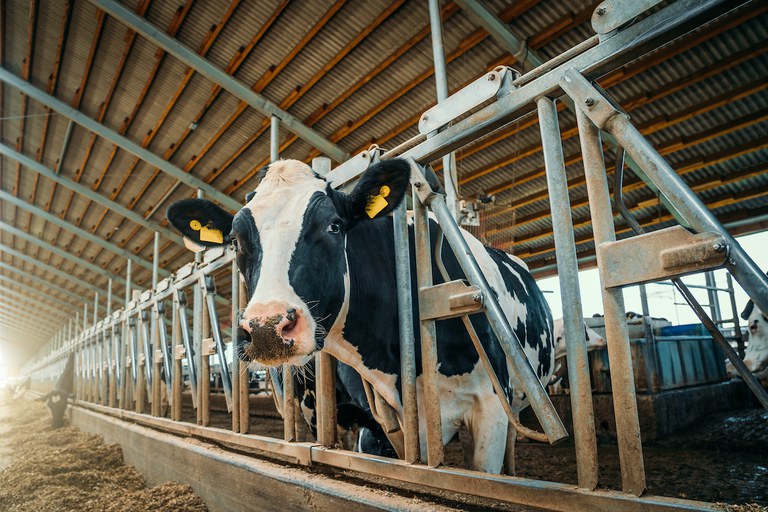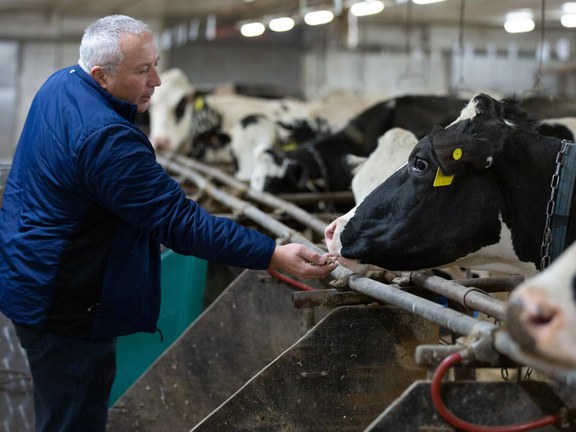Finding safe, affordable, and beneficial ways to reduce the carbon footprint of producing milk
Problem
Can greenhouse emissions from animal agriculture be reduced without compromising productivity?
- Methane's atmospheric warming potential is as much as 2 8-36 times higher than that of carbon dioxide over 100 years.
- The average dairy cow belches 350 pounds of methane each year as a natural byproduct of its digestion, accounting for approximately 2.7 percent of total U.S. greenhouse gas emissions.
Findings
Animal scientists studied how 3-nitrooxypropanol (3-NOP), a compound that inhibits the synthesis of methane in a cow's rumen, affected the cow's enteric methane emissions as well as milk production and quality.
- Supplemented feed decreased the cow's methane emissions by about 29 percent without affecting the sensory qualities of the milk and also increased the milk fat percent and the feed efficiency per unit of milk yield.
Impact
The use of 3-NOP to supplement cattle feed provides a safe and economical way for farmers to affordably reduce the carbon footprint of cattle production and benefit from increased feed efficiency.
- Cows quickly metabolize the small synthetic molecule, which falls apart into naturally occurring compounds present in the rumen.
- The study is a critical step in the approval process for use of 3-NOP as a methane mitigant in ruminant production.
Related Research Area: Advanced Agricultural and Food Systems
Research Credit
Team
- Alex Hristov, Troy Ott, Audino Melgar, M. T. Harper, J. Oh, F. Giallongo, M. E. Young, Stephane Duval, C. F. A. Lage, K. Nedelkov, S. E. Räisänen, H. Stefenoni, X. Chen
Participating Departments
Partners
- DSM Nutritional Products
Competitive Funding
- DSM Nutritional Products
Federal and State Appropriations
- USDA NIFA Hatch Multistate Project PEN04664, Accession # 1017181
Emerging Discoveries
Published Research
Full adoption of the most effective strategies to mitigate methane emissions by ruminants can help meet the 1.5 °C target by 2030 but not 2050
-
Arndt, C., Hristov, A. N., Price, W. J., McClelland, S. C., Pelaez, A. M., Cueva, S. F., Oh, J., Dijkstra, J., Bannink, A., Bayat, A. R., Crompton, L. A., Eugéne, M. A., Enahoro, D., Kebreab, E., Kreuzer, M., McGee, M., Martin, C., Newbold, C. J., Reynolds, C. K., ... Yu, Z. (2022). Full adoption of the most effective strategies to mitigate methane emissions by ruminants can help meet the 1.5 °C target by 2030 but not 2050. Proceedings of the National Academy of Sciences of the United States of America, 119(20), Article e2111294119. https://doi.org/10.1073/pnas.2111294119
Dose-response effect of 3-nitrooxypropanol on enteric methane emissions in dairy cows.
-
Melgar, A., Welter, K. C., Nedelkov, K., Martins, C. M. M. R., Harper, M. T., Oh, J., Räisänen, S. E., Chen, X., Cueva, S. F., Duval, S., & Hristov, A. N. (2020). Dose-response effect of 3-nitrooxypropanol on enteric methane emissions in dairy cows. Journal of dairy science, 103(7), 6145-6156. https://doi.org/10.3168/jds.2019-17840
Effects of 3-nitrooxypropanol on rumen fermentation, lactational performance, and resumption of ovarian cyclicity in dairy cows
-
Melgar, A., Harper, M. T., Oh, J., Giallongo, F., Young, M. E., Ott, T. L., Duval, S., & Hristov, A. N. (2020). Effects of 3-nitrooxypropanol on rumen fermentation, lactational performance, and resumption of ovarian cyclicity in dairy cows. Journal of dairy science, 103(1), 410-432. https://doi.org/10.3168/jds.2019-17085
Emerging Discovery
Office for Research and Graduate Education
Address
217 Agricultural Administration BuildingUniversity Park, PA 16802-2600
- Email agresearch@psu.edu
- Office 814-865-3136
Emerging Discovery
Office for Research and Graduate Education
Address
217 Agricultural Administration BuildingUniversity Park, PA 16802-2600
- Email agresearch@psu.edu
- Office 814-865-3136









